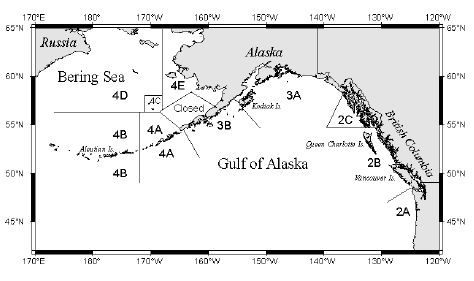 By Laine Welch December 09, 2006
Alaska always gets the lion's share of the halibut harvest, and the state could see an overall increase to nearly 56 million pounds, up about a half million from 2006. Preliminary numbers show slight increases for all regions in the Gulf of Alaska and Bering Sea - except for Southeast. Biologists are recommending a halibut catch of seven and a half million pounds for the Southeast region, a drop of three million pounds from this year. The IPHC based its numbers on a new model after recoveries of tagged halibut showed a greater movement of fish among regulatory areas than previously thought. Accordingly, the managers developed a coast-wide assessment based on a single stock, rather than assessments for each of eight regions. The result was some substantial changes in catch rates. The catch recommendations, along with other halibut issues, will be considered by the IPHC at its annual meeting set for Jan.16-19 in Victoria, British Columbia. The catch limits may be updated, but they are not expected to change significantly, the Commission said. The IPHC will take public comments on the catch recommendations through December 31st. The fishery will open most likely in early March and last through mid-November. Below are the Alasks catch recommendations in millions of pounds:   Pay up time - Alaska longliners lucky enough to hold quota shares of halibut and sablefish (black cod) pay a fee each year to the federal government to cover the costs of managing and enforcing those fisheries. The "cost recovery" fee is capped at three percent of the value of the landed catches. The bills are in the mail to roughly 2,500 harvesters - and good news - they will pay only one percent this year, down from 1.6 percent in 2005. The reduced fee stemmed from lower agency costs and higher fish prices, according to Tracy Buck, permit operations manager at the Restricted Access Management Division of NOAA Fisheries in Juneau. "We had to redirect a lot of staff to get the crab rationalization permits out the door and other things dealing with that new fishery," Buck explained. As for Alaska halibut and sablefish prices, they reached an all time high. "The average price for halibut during 2006 was $3.71 a pound, up about 70 cents from the prior year and up almost a dollar from 2004. For sablefish, the average price was $2.45 a pound, up about 35 cents from 2005," Buck said. The value of the 2006 halibut fishery topped $193 million at the docks, up $25 million from 2005. For sablefish, the dockside value topped $75 million, up $5 million from last year. Deadline for fishermen to pay the fee to the feds is January 31st. Set netters say no to Bristol Bay RSDA - Bristol Bay set netters voted not to participate in a new Regional Seafood Development Association, or RSDA. A total of 446 of the roughly 980 set net permit holders voted in a recent election, and 305 said no. By state law, 30 percent of a gear group must vote and a majority prevails. Earlier this year, a majority of Bristol Bay's nearly 2,800 drift net fleet cast votes in support of an RSDA, which will be funded by a one percent tax on their salmon catches. Tax revenues were collected on the drift fleet this summer and roughly $800,000 will be available to the RSDA next year. The money is collected by the state and then appropriated back to the associations. It can be used to market and promote the region's seafood, conduct research or product development or improve infrastructure. The nay vote by set netters means those salmon fishermen will have no voice in the projects and programs developed by a soon to be elected board of directors. "They were not convinced about the economic benefits to pay the tax," said set netter and interim RSDA board member Cecil Ranney. "We got a big bogged down talking about providing ice and improving quality for the past few years, but the price has remained stagnant. We probably should have emphasized developing more markets and promotions." "We might revisit it after we see how things go with the drifters. And any promotions will benefit us all," Ranney said, adding that he believes a set netter should have a seat at the RSDA table to stay informed. "We have never had an area wide organization that included all salmon fishermen, and that would be a real positive thing." State managers project the
2007 sockeye salmon harvest at 26.3 million reds, just slightly
below this year's projection. The catch came in higher than expected
with fishermen delivering nearly 29 million sockeyes, valued
at $91 million. Bristol Bay produces nearly one third of Alaska's
total salmon harvest each year, and is the state's largest salmon
fishery.
Publish A Letter on SitNews Read Letters/Opinions Submit A Letter to the Editor
|